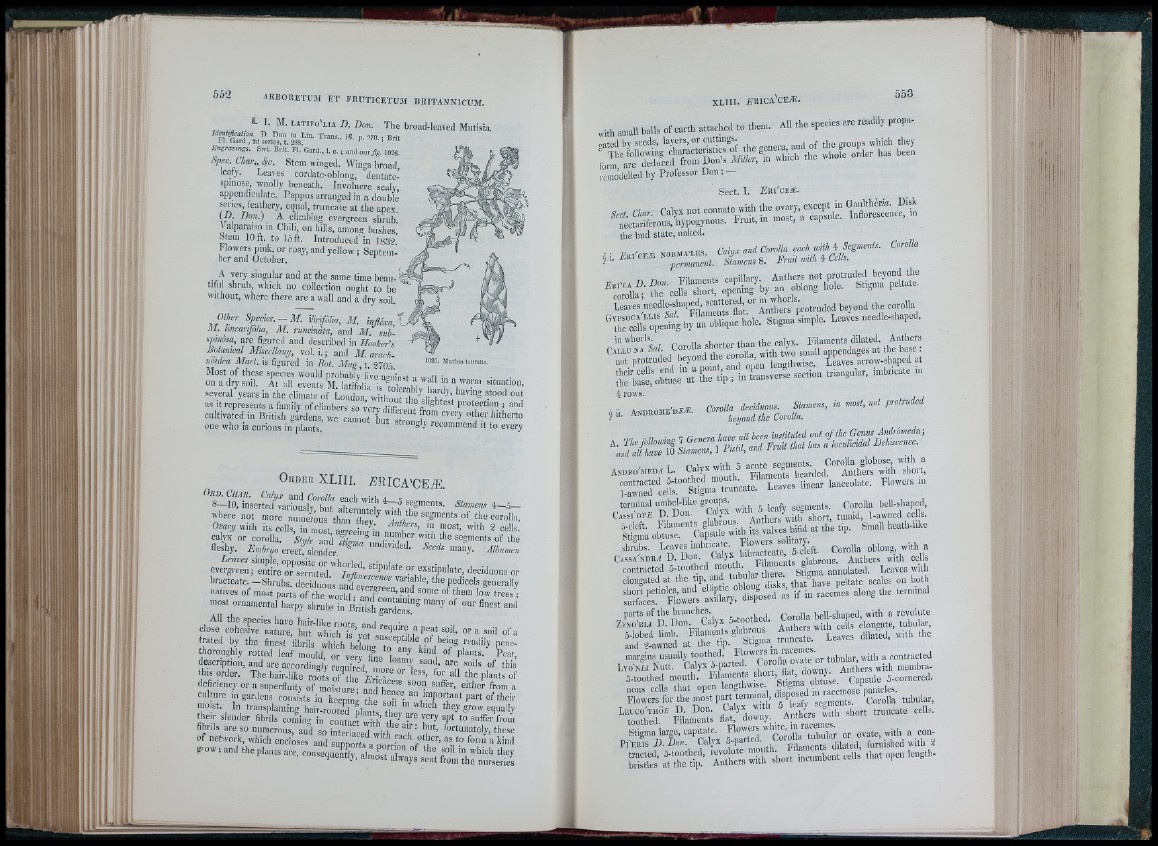
■t.i
a - 1 . M. L A T I F O 'H A D. Don. The broaci-leaved Mutisia.
M M i^ aU o n T,. Don in Lin. Tran 16. p. 'irO. ; Brit
I'l. Gard., 2d series, t. 288.
Engravmgs. Swt. Btlt. Fl. Gard., 1. o. , .and o u r * . 1026.
Spec. Char. f r . Stem winged. Wings broad,
leaty. Leaves cordate-oblong, dentate-
spinose, woolly beneath. Involucre scaly
appendiculate. Pappus arranged in a double
series, feathery, equal, truncate at the apex,
if 1 A climbing evergreen shrub.
Vaiparai.sq in Chili, on hills, among bushes,
fetem 10 ft. to 15ft. Introduced in 1832
Flowers pink, or rosy, and yellow : Septemè
ber and October.
A very singular and at the same time beautiful
shrub, which no collection ought to be
without, where there ai-e a wall and a dry soil.
other Spec-tes.-M. Micfrlia, M. in f lé x a Y
M. hnearifolia, M. rundnàia, and M , sub-
spinósa, are figured and described in HooJcer’s
Botanical Miscdlany, vol. i.; and M. arachnoidea
Mart, is figured in Bot. Mag , t. 2705 ------
1026. M utisia latifòlia.
Most of these species would nrobablv live a<£ln^f n • - .
on a dry soil. At all events M. latifòlia is Id e fa b v Ì
several years in the climate of London, without th / s l ff itZ n ?
as It represents a family of climbers so very (lifferent f r ? protection ; and
cultivated in British gardens, we e an n ? b, t s Ì ,? f "fr®''/
one who is curious implants.’ rocommend it to every
O r d e r X L I I I . iR I C A 'C E u E
t - f ,T— ■ Z s ‘.ft 'ft "rrzftft* rs; calyx or corolla. Style and r s e g m e n t s of the
fleshy. Embryo erect -slender ivuled. Seeds many. Albumen
bracteate. - Shrubs, d e d Z L ¿ d Z o r i " ‘’“® P®"'®®‘® g®"®''""!
natives of most parts of the world J P®®"’ ?pd some of them low trees ;
most ornameutal harpy shrnbs in BrZsh g?de„T®
close cohestoe natore! w f o c h A y Z l S S b Z
rated by the finest fibrils which belong to Z v k? I f ® P®"®‘
thoroughly rotted leaf mould, or verv fine l o ? , “ P ‘®' P®"'>
description, and are accordingly reoulred n.ori ! "® this
this order. The hair-like roots o ? ? k ? ’ *® P>""ts of
deficiency or a superfluity of moisture Z d h ? * ’ ®“ "®'’ fr®” "
cnlture in gardens consists in keepini t h Z P " ‘ fo®"’
moist. In transplanting hair-rooted f,i A T fo®¥ g™"'
the.r slender fibrils conflng in coZaet ? i h Z r i "P‘ “ > S“«“® f-'oi
r o w ; and theplants are, c o n s e q S ^ A r r A £
with small balls of earth attached to them. All the species are readily propa-
«ated by seeds, layers, or cuttings.
w b Z has bee„
reniodelled by Professor Don ; —
Sect. I. jE r i 'o b i e .
the bud state, naked.
* ' ‘'f t - r f t r i r f f t r - -
to fti r ..S‘= L e a v e s needlerthaped s c a t t y p ro tru d ed beyond th e corolla
b y " u e t l e . Stigma"simple. Leaves needle-shaped.
m whorls Filaments dilated. Anthers
C.VLLCI NA 5a/. fo ,? corolla, with two small appendages at the base ;
not protruded beyond the co lengthwise. Leaves arrow-shaped at
Z ? t e s e e r i ^ ^ triangular, imbrieate m
4 rows.
f t f t « f t " .
I . c . i „ .1,1. ! —
cSft a“ ' "fp «i V i . ..S'fti-si
i,t i . s r y f t s i .. .1.. '«■ “ ■»
zSft ÌE'.'ftì,- «•••"■ ss; Stftftftrbft.
.ft“
rnargins usuaUy to o th ed . F low ers n y ra ^ tubular, with a contracted
t f t . r f t y p s . »— • p f t i „ m . .
Stigma large, capitate. ? ° " '® f t "" tubular or ovate, with a cou-
PPe Pis D . D o,, Calyx 5-pat e ^ furbished f t t h 2
toStZs’ a Z r t i p . ’ T n to e rsw ith short iucumbent cells that open length-
IS'I
i 'i' I
.L l iL